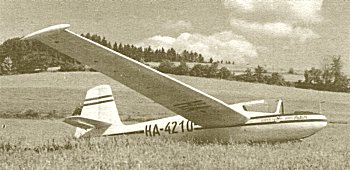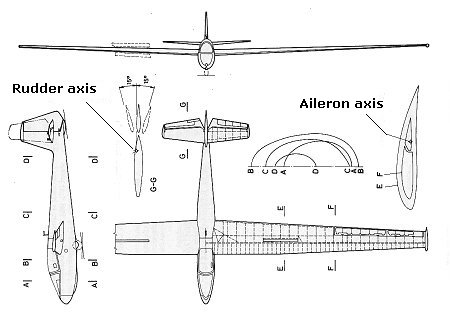| Type designation: | R-22SV |
|---|---|
| Name: | Standard Futár (D Futár) |
| Designer: | Ernő RUBIK |
| Class: | Standard |
| General arrangement: | Cantilever mid-wing, closed cockpit, retractable wheel, traditional tail unit |
| Crew: | 1 |
| First flight: | May 1958 |
| Manufacturer: | Sportárutermelő V., Esztergom (former AeroEver Ltd.) |
| Number of built: | 1 |


| Dimensions: | |
|---|---|
| Wing: | |
| Span, m: | 14,98 |
| Area, m2: | 12,66 |
| Aspect ratio: | 17,8 |
| Chord (root), m: | 1,15 |
| Chord (tip), m: | 0,48 |
| Airfoil (root), m: | Gö 549 mod |
| Airfoil (mid-span), m: | Gö 549 mod |
| Airfoil (tip), m: | W-192 |
| Dihedral, degree: | 2,5 |
| Sweep, degree: | -1 |
| Washout: | Aerodynamic and -3 degrees geometric |
| Aileron: | |
| Span, m: | 3,44 |
| Mean chord, m: | 0,458 |
| Total area, m2: | 1,55 |
| Balancing: | Aerodynamic |
| Flap: | |
| Type: | None |
| Airbrakes: | |
| Type: | Göppingen |
| Position (upside/downside): | u/d |
| Total area, m2: | 0,495 |
| Position, % of chord: | 0,42 |
| Horizontal stabilizer: | |
| Span, m: | 3 |
| Area, m2: | 1,807 |
| Elevator: | |
| Span, m: | 3 |
| Area, m2: | 0,542 |
| Airfoil: | symmetric |
| Balancing: | Aerodynamic |
| Trim: | Yes |
| Vertical stabilizer and rudder: | |
| Total area, m2: | 1,267 |
| Rudder area, m2: | 0,667 |
| Balancing: | None |
| Fuselage: | |
| Length, m: | 6,48 |
| Width, m: | 0,6 |
| Height: | 0,97 |
| Cross section, m2: | 0,52 |
| Landing gear: | |
| Type: | Retractable |
| Wheel diameter, m: | 0,26 |
| Masses: | |
| Wing, kg: | 115 |
| Fuselage, kg: | 82 |
| Tail unit, kg: | 12 |
| Empty glider, kg: | 230 |
| Gross, kg: | 340 |
| Ballast, kg: | None |
| Wing loading, kg/m2: | -26,9 |
| Speeds: | |
| VNE, km/h: | 190 |
| Max. speed with open airbrakes, km/h: | 190 |
| Max. aerotow speed, km/h: | 130 |
| Max. winch speed, km/h: | 80 |
| Max. speed in rough air, km/h: | ? |
| Stall speed, km/h: | 62 |
| Performance: | |
| Min. sink, m/s (at gliding speed, km/h): | ?/65 |
| Best L/D (at gliding speed, km/h): | 28/80 |
| Start methods: | Winch, Aerotow |
Origin of data and 3-view drawing:
Jereb Gábor: Magyar vitorlázó repülőgépek, Műszaki Könyvkiadó, 1988, Budapest
(Gábor JEREB: Hungarian Gliders, Technical Publishing House, 1988, Budapest)
Gábor FEKECS E-mail: fekecs.gabor@t-online.hu